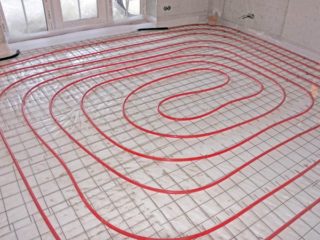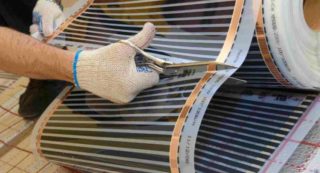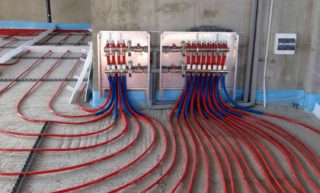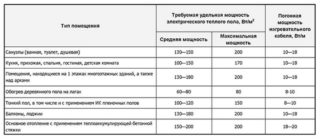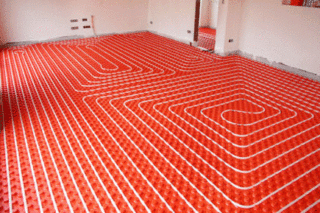Underfloor heating - a system of primary or secondary heating of a room. Heating elements are placed in the floor - in a concrete screed or a layer of glue. First of all, the floor and furniture are heated. This option creates a feeling of comfort and is more economical.
The main types and choice of underfloor heating
There are 2 main types of floor heating: water and electric. The first is a modification of ordinary water, where thin tubes are used instead of radiators. Its operation requires no more gas or electricity than for heating with conventional batteries.
In the electric version, the heating elements operate from the network. Its cost is much higher, since electricity is an expensive source of energy. But underfloor electric heating is extremely safe and effective. It can be mounted not only in residential and utility rooms, but also on the balcony, loggia or even on the porch.
Water
The principle of operation is similar to a conventional autonomous system. From the boiler, the heated liquid enters the collector, where it is distributed along the contours. Underfloor heating in each room - a separate circuit. Combining the entire system into one circuit is not recommended, because then, if a breakdown occurs without heating, the whole house remains.
The basis of the heater is thin polypropylene tubes. From the collector, heated liquid enters the tubes, heat is transferred to the floor surface. The distance between the pipes can be varied: if the two-story house has high ceilings, the step between the elements is minimized to warm up a large room. If the ceilings are low with the same room area, the step between the tubes is increased.
The heating temperature is regulated by the collector. Until the set indicator is reached, the pump is running and thermostatic valves are open, through which hot water enters the pipes. When the temperature is as specified, the pump shuts off and the valves shut off.
Underfloor heating can only be installed in private homes. Even if the apartment has an autonomous boiler and the installation of the system does not affect the heating in another apartment, it is forbidden to do this. Although the pipes are placed in a concrete screed, there is a risk of leakage and damage. With a leak, flooding of the apartment from below is guaranteed. Given that repairing a warm floor takes a long time, the costs will be very significant.
Do not connect water heating to central heating. This is strictly prohibited and punishable by a fine.
Water floors are distinguished by the material of the pipes:
- The copper pipe is not subject to corrosion. Extremely durable - it works up to 50 years without repair, withstands high temperatures and water hammer. Even when the coolant freezes, the copper pipes do not crack. The disadvantage is the high price and complicated installation. When installing, you can not connect steel and copper pipes, so you have to buy bronze adapters.
- Metal-plastic is no less durable and resistant to corrosion. Chemically and biologically completely inert. The pipeline weighs little; it is much easier to mount it than copper. Disadvantage: risk of loose fittings during heavy use. This makes installation difficult, as it is necessary that only areas without joints are under the concrete screed.
- Polypropylene is rarely used due to its high stiffness, and the pipes must be bent during masonry. It is used in extreme cases.
- Cross-linked polyethylene piping is not subject to any kind of corrosion. Withstands operating temperatures up to +95 C, is not afraid of water hammer.The main advantage is high flexibility and the absence of creases. The minus is combustible, which is not of particular importance for floor installation.
Water floor heating is placed only in a concrete screed. The construction of such a floor requires a lot of labor and time - it takes only 28 days to harden the concrete. The height of the room is reduced by at least 15–20 cm.
Electric
The heat source is a material that heats up with the passage of current. The heating element has the form of wires, rods, plates, films. Underfloor heating is possible both in apartments and in private houses. The heating temperature is regulated very precisely, the room becomes warm in a few minutes after switching on. A definite plus: the ability to install on the smallest areas and with the most complex area configuration.
A common drawback for all electrical appliances is the consumption of electricity. Because of this, this option rarely acts as the main heating. In living rooms, the warm floor is combined with radiators, in the bathroom, in the bathroom, in the loggia is used independently. But here the area is small, so the consumption is low.
There are 4 main varieties of electric underfloor heating:
- Cable - the basis is single, two-core and self-regulating cables. The wires are laid in a concrete screed according to one of the schemes. Depending on the pitch between the loops, the floor heats up more or less.
- Thermomats - the same cable, but fixed to the grid with a step of 9 cm. This device facilitates installation, but at the same time limits the area: mats cannot be shortened.
- Film IR heaters - carbon strips act as a heating element. When current flows, they emit infrared radiation. It does not heat air, but surfaces, objects and people, and only then air. At the same time, a lower temperature feels like a higher one, which allows to reduce the heating intensity and save electricity. They lay the IR film in the screed and in the adhesive layer.
- Rod - a type of infrared heater, where carbon rods are used instead of strips. According to the device, they are closer to thermomats: the rods are mounted on a plastic mesh. Its price is much higher than film, but it is much more durable - up to 50 years.
It is possible to reduce energy consumption even in a two-story building by installing an electronic programmable thermostat. At night and when there are no people in the house, it reduces power to a minimum.
Advantages and disadvantages of underfloor heating as primary heating
The main advantage is comfort. The warm floor underfoot creates a feeling of warmth and comfort much faster than the hot air of a room. There are other benefits:
- Uniform warming up the room. Heat comes from the entire floor area, while batteries partially warm the walls and only distribute heat to a specific area.
- The system works completely silently.
- Since the heating elements are enclosed in a screed, heating has less effect on the humidity level.
- You can choose an option with different thermal inertia. The water floor slowly heats up and cools for almost a day. IR film instantly heats the floor surface and cools just as quickly.
- Heating with underfloor heating is cheaper than radiators. The cost of electric heating is not so attractive.
- Mount systems on the smallest sites, even on staircases.
- Batteries do not decorate the room and do not fit into the interior. Underfloor heating elements are hidden from view.
Disadvantages:
- Arrangement of a warm floor is a laborious and lengthy process. Hydro and thermal insulation is laid on a base base. Then place a reinforcing mesh or mats for laying.They place the tubes, make the connection, pour the concrete screed, lay the substrate and lay the final floor. It takes time and money.
- Water underfloor heating takes at least 10 cm of height, and electric - from 3 to 5 cm.
- Repair is very difficult: in case of damage, it is necessary to remove the coating, break the screed, eliminate defects and re-lay the floor.
It is possible to mount an electric heat-insulated floor not only on the floor, but also on the walls.
Recommended Capacities
Warm electric floor as the main heating copes with its task, if it has the appropriate power. The calculation depends on the type of heating element:
- The heating cable parameter is the linear power. On average, it is 18 W / m. Knowing the value, it is easy to calculate how much cable is needed to heat 1 sq. Km. m
- The indicator for a cable mat is power density. Produce products with a capacity of 150 watts per 1 square. m. Less common are modifications with a capacity of 200 watts.
- Infrared films are more powerful - from 130 to 230 W / sq. m. They are often used as the main heater.
- Rod mats produce power from 130 to 160 watts per 1 square. m
The indicator is selected based on the destination. In living rooms, for the main heating, floors with power from 120 to 180 W / sq. Are required. m, for the bathroom - 120-150 W / sq. m, for a loggia - up to 230 W / sq. m
Calculation and selection of equipment
Heating a house with underfloor heating requires an accurate calculation:
- The useful area of the room is calculated - the warm floor is not laid under furniture or stationary equipment. At the same time, the heated area should be 50, and preferably 70% of the total.
- Calculate the heat loss in the room. It depends on the general insulation, the number of windows and doors. Calculate the value with a margin of 30%.
- If the system is stacked in a heat-accumulating screed, the correction factor is increased to 1.4.
- The heating power under the wooden or tile floor should be less than the heat loss power, multiplied by a factor. If the heat loss in the kitchen, for example, is 1000 watts, the power of the floor heater should be at least 1000 * 1.3 = 1300 watts.
- The specific power is calculated by dividing the necessary by the usable area. If in the kitchen it is 7 square meters. m, for its heating you need a warm floor with a capacity of 1300/7 = 186 W / sq. m
- Pick up the system. If a heating cable is laid, from the entire list, select a wire whose power matches the calculated one. Acquire a cable of the length indicated in the table.
- Calculate the installation step: the effective area is multiplied by 100 and divided by the length of the cable. During installation, this distance is carefully observed.
The power of other options is also calculated according to a similar scheme: heating mat, IR film, core floor.
